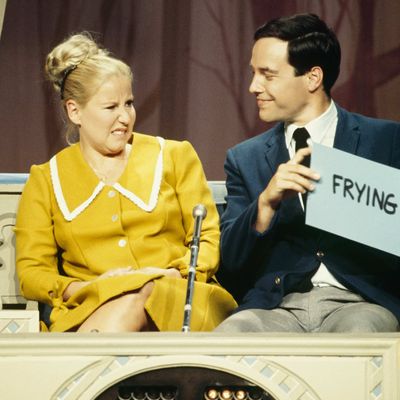
When your partner is your best friend — someone who really gets you, you know? — it’s a wonderful thing. And yet thinking of marriage as the ultimate BFF-ship potentially comes with its own set of problems, setting some lofty expectations for the relationship. It often means that this is the one person to whom you look to meet your deepest psychological and personal growth requirements; it’s the tippy-top of the old Maslow’s Hierarchy of Needs pyramid, in other words.
When it works, it’s bliss. But according to the authors of a new paper in Current Directions in Psychological Science — lead-authored by Northwestern University’s Eli Finkel — it’s also incredibly difficult to meet these huge and time-consuming demands, meaning the modern American marriage has the potential to be both much better and much worse than ever before. Because here’s the twist: At the same time Americans are asking more out of their marriages than ever, they’re also spending less time with their spouses.
Modern American marriages are more strongly linked to psychological well-being — happiness, basically — than they were in decades past, according to a review of 93 studies from 1980 to 2005, and the authors on this current paper, led by Northwestern University’s Eli Finkel, believe they know why. Basically, they think Americans have begun understanding their marriages in a different, historically unusual way than they used to.
To Finkel and his co-authors, there have been three major eras of marriage in American history, cultural shifts in what’s largely considered the fundamental purpose of the institution. In the country’s earliest years, marriage was there to help people meet basic economic needs — someone to help harvest the crops and keep warm in the winter. Then there was a middle era, from about 1850 to 1965, when employment shifted to outside the home, and the point of marriage was to be a source for love and passion.
Today, Finkel and his colleagues argue, it’s a “self-expressive era” of marriage, in which Americans look to the institution “to fulfill needs like self-esteem, self-expression and personal growth.” Finkel expanded on that in an email to Science of Us:
As we have increasingly come to look to our marriages to help us achieve our deepest psychological needs—rather than helping us harvest crops or even just loving us, for example—we need much stronger communication and responsiveness than ever before. More and more marriages are struggling to achieve those lofty standards, especially on top of all of the other stresses in our lives.
However, those of us who succeed in building a marriage that can meet our deepest psychological needs—a marriage that helps us become closer to our ideal self—are immensely satisfying. That is, achieving a successful marriage today is tougher than in the past, while at the same time the payoff for such achievement is larger than in the past.
Helping your partner harvest crops or weather a drought or prepare for winter wasn’t easy, in other words, but these things also didn’t require deep contemplation and understanding of his or her innermost thoughts and desires. Meeting these self-actualization expectations takes some serious face time together, and yet the evidence shows that at the same time Americans are demanding more out of their marriages, they’re also putting less time into them.
To wit, as Finkel and his co-authors point out: From 1975 to 2003, the amount of times childless couples spent together, just the two of them, dropped from 35 to 26 hours per week. The decline in togetherness-time is most likely explained by a rise in time spent working. During that same time period, couples with kids saw a similar dip in time spent one-on-one, from 13 to 9 hours per week. This decline appears to be owed to an uptick in what the researchers called “time-intensive parenting.”
And these problems are likely exacerbated for lower-income couples, who likely have less time or money to devote to the kind of quality time needed to meet today’s marriage expectations than their wealthier counterparts. But the research shows that lower-income couples still very much want the same things out of marriage as higher-income spouses.
It’s not hopeless, however. There are a few ways of improving marriage quality, none of which take huge amounts of time, which Finkel and his co-authors helpfully outline in their paper:
If you want to get nerdy about it, you guys can take on some writing exercises. The researchers cite a study that found couples who spent just 21 minutes a year writing about their conflicts through the eyes of an impartial third party saw improvements in their relationships over the following two years. It’s not going to magically turn a dissatisfying relationship into a blissfully happy one, but it’s a pretty simple way to give it a nudge.
Schedule regular “date nights.” (There’s a reason it’s a cliché.) It’s because scheduling time together really works to improve the relationship, the research suggests. Spending more fun hang-out times for just the pair of you will likely help increase the odds that you meet each other’s psychological needs.
Seek at least some of that self-actualization stuff elsewhere. Find a hobby, join a group, call your friends — shift at least some of that personal-growth burden off of your relationship. “Doing so can bring the demands on the marriage into closer alignment with the available resources,” the authors write, “thereby reducing dissatisfaction from unmet expectations.”
It’s not impossible to have a successful marriage in this “self-expressive” era, Finkel said, but we’re only just starting to learn how to do it. (Incidentally, he’s currently writing a book on that very subject.) Finding a balance between sky-high expectations and the time people can realistically invest in their relationships seems like one way to start.




